How much are you willing to spend on a car to spend nothing on gas?
This question arises – or ought to arise – whenever electric cars are discussed.
Especially an electric car like the Nissan Leaf, which – unlike a Tesla3 or Model Y – isn’t ludicrously fast or the least bit sexy.
What it has going for it, chiefly, is that it’s a lot less expensive than a Tesla Model Y – and a lot more practical than a Tesla Model 3, which is an electric sedan with a small trunk vs. the hatchback’d Leaf’s much larger cargo area.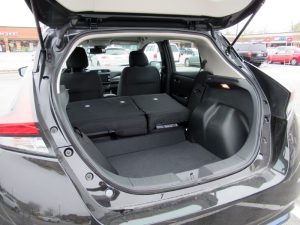
But it has a number of things not-going for it, too – chief among the downsides being newer/more practical rivals.
And “the math.”
What it Is
The Leaf is Nissan’s entry into the electric car arena.
It’s available in standard range (150 miles) and extended range (225 miles) versions, with prices beginning at $31,600 for the base S trim with the less powerful 150-mile range battery and topping out at $43,900 for the SL Plus trim with the 226-mile higher-performance battery.
You can also buy the less expensive S trim with the higher-performance battery (S Plus) for $38,200.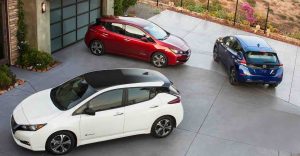
The Leaf’s most direct rival is the Chevy Bolt, which though more expensive ($36,200 to start) is also a hatchback with cargo space rather than a trunk that emphasizes practicality over sex appeal and speed.
Another possible cross-shop is the Kia Niro EV, which is also a practically laid-out hatchback that’s about the same size as the Leaf. But it’s even more expensive – just under $40,000 to start – which gives the advantage to the Leaf.
If the math matters to you.
2021 is a carryover year before what is expected to be a major reboot of the Leaf for the 2022 model year. Which means you could probably get a really good deal on this Leaf, which Nissan has been massively discounting by as much as $6,000 off the MSRP – in addition to whatever you can take off your taxes for the electric car credit.
But it also means that if the 2022 Leaf comes standard with more range for about the same or even less money, your ’21 will probably depreciate even faster than electric cars already depreciate – which is much more and much sooner than non-electric cars, because of the shorter life and high replacement cost of electric car batteries.
We’ll get to the math shortly.
What’s Good
Base S trim is the most affordable electric car on the market.
Hatchback layout is practical.
Very roomy up front.
What’s Not So Good
Base S trim has the shortest range of any electric car on the market.
Kia Niro EV and Chevy Bolt have more cargo room – and more standard range.
Less backseat legroom than others in the class.
Under The Hood
The base Leaf comes with a 1-speed electric motor directly powering the front wheels, fed by a battery pack capable of holding enough charge to let you travel up to about 150 miles before you have to stop to recharge – which takes about 7.5 hours on standard 120V household current.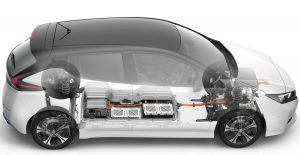
Plus models get a larger, stronger battery that increases the Leaf’s range to about 226 miles – but the time to recharge also increases, to 11.5 hours (on 120V household current).
The Leaf’s closest-in-cost rival, the Chevy Bolt, comes standard with a 259-mile range and a 10 hour recharge time.
The much-more-expensive Kia Niro EV comes standard with a 239 mile range.
All can be recharged faster, but only if you have access to a fast charging system, either at home or wherever you stop. These will get you back on the road in under an hour (though not fully recharged in under an hour). Be aware that you’ll probably need to have some wiring work done at your home if you want to fast charge at home, since most homes were not wired for EV charging when they were built.
Be sure to add the cost of the electrician – and the necessary components – into your figuring.
Also, the option.
The base 150-mile Leaf does not come standard with fast-charge capability. If you want to get going in less than several hours, add $1,690 to the Leaf’s price – the cost of the Charge Package.
Plus models come standard with it – but of course, you’re also paying a lot more for it.
On The Road
The Leaf is not a performance car but it performs adequately for its intended role as a transportation appliance that happens to be electric. Zero to 60 takes about 8.8 seconds, which is par for non-electric transportation appliances.
It feels quicker than it is, too – and is much quieter. Almost silent, which is a weird experience if you’ve never driven an electric car.
All of the torque developed by the Leaf’s electric motor is available immediately, which is an inarguable EV advantage. And EV motors also generate enormous torque – another inarguable EV advantage. The Leaf’s electric motor produces 236 ft-lbs. of torque at zero RPM. The torque number is comparable to that of a gas-burning 3 liter V6 engine – but without any revving to reach it.
From a dead stop and in stop and go traffic, the Leaf launches with more authority than any IC economy car and some IC performance cars. You can use this – plus the car’s silence – to get the drop on traffic, thread through holes and make your own holes.
Keep in mind, however, that everything that’s powered in an electric car is powered by the battery pack, including the heater, the AC and headlights. Use of these accessories will reduce your range, as will high-speed driving and “fast” starts.
This is equally true as regards driving a non-electric car hard – and using power-driven accessories such as the AC. But the big difference is you don’t have to worry about it because you can quickly refuel a non-electric car’s tank while it takes much longer to instill even a partial charge in an EV’s battery. This makes being aware of how much electricity you have left in the battery more immediately important than how much gas you’ve got left in the tank.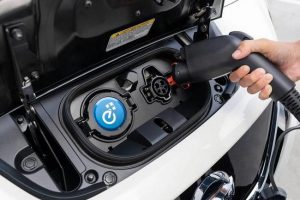
Driving the Leaf means watching the range left as much as the road – because it determines not merely how soon you’ll have to stop but how long you’ll have to wait. Which could be hours, if you can’t find a “fast” charger – a real threat because they are not like gas stations, just around the corner or a couple of miles down the road. The next-nearest one might be too-many-miles down the road for the range you have left.
Plan accordingly.
However, an EV can also do something that gas-powered cars can’t – which is to recover power without stopping by using inertia. What this means is that although you’ll lose a lot of range going up a hill – which takes power – you can recover it going down the hill, which uses no power. The wheels act as generators, using the rolling of the car to recharge.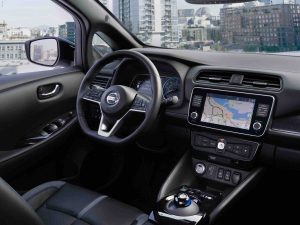
Hybrids do the same thing. EVs do it, too.
Other than that, the Leaf drives like what it is, which is a basic A to B appliance.
It’s much heavier than a non-electric A to B transportation appliance – close to 4,000 lbs. for the Plus model, chiefly because of the weight of its batteries – but the weight is only obvious in the curves and only if you’re going fast – which is contra the point of owning a car like this.
Faulting it for feeling heavy in the corners would be like denouncing a Corvette for being terrible in the snow.
Speaking of that.
The Leaf is probably better in the snow than most A to B appliances precisely because it is so heavy. More precisely, because there is so much weight over the drive wheels, which is always a traction advantage (one of the first front-drive cars was called the Traction Avant for just that reason; the weight of the engine over the drive wheels gave it a traction advantage over rear-drive cars with not much weight over their drive wheels).
When the Leaf came out, it boasted much more practicality than sex-appeal EVs like the Tesla3 – with its tiny 15 cubic foot trunk. The hatchback’d Leaf has twice as much cargo space – 30 cubic feet behind its third row.
That gives it more working room for stuff than any full-sized sedan on the road – which explains why hatches (and crossovers, which are similarly laid out) have become much more popular than sedans, especially the small ones.
But the Leaf has competition on the practicality front from the Bolt – which has almost twice as much space for stuff – 56.6 cubic feet of cargo space with its backseats folded and 36.5 inches of backseat legroom, vs. the Leaf’s a-lot-tighter 33.5 inches of backseat legroom.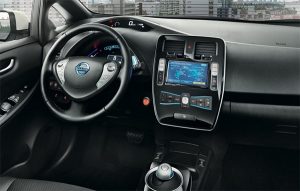
Ditto the Niro EV, which has 53 cubic feet of total cargo capacity, 18.5 cubic feet behind its backseats and 36 inches of backseat legroom.
However, both the Bolt and the Niro are much more expensive, which makes a direct comparison a little unfair. You’d be paying almost $5k more for the extra space in the Bolt and about $8k more to enjoy the extra space – and greater range – of the Niro.
There’s another comparison that’s more fair – in terms of not getting what you’re paying for vs. a non-electric equivalent. The Leaf is a very basic car as it comes, given what it costs – if you set aside its electric car guts.
The base S includes AC, a tilt-only wheel and an 8-inch LCD touchscreen – plus a bevy of “safety” and “driver assistance” apps. The thing is, you’d get the same in a $17k non-electric equivalent, like Nissan’s Versa, for instance.
You can get amenities such as leather trim, an upgraded audio system, power seats and LED lights – plus an updated dash layout – but now you’re pushing almost $40k for what is still the amenities-equivalent of a well-equipped entry-level compact hatchback that would cost you $15-20k less – and go twice as far before you had to stop.
The Rest
It’s hard to make an economic case for any EV, even this most-affordable of EVs. And not just because it’s doubtful you’ll ever recover the roughly $15k-$20k difference in cost to buy via not buying gas vs. buying an otherwise similar but not-electric transportation appliance that dos burn gas.
There is the additional hidden cost of battery replacement, which is an inevitable part of EV ownership because all EV batteries lose their capacity to hold a charge over time.
Which time is less than the usual 15-20 year lifespan of almost any new car.
The problem isn’t just the expense of replacing a tired battery, either. It is the cost of replacing the tired battery – generally around $5,000 – vs. the depreciated value of the EV itself by the time it needs a new battery.
This is why you can find 5-6 year old used Leafs on the market for less than $10k.
Another cost to consider is the how much time you’ll spend plugged in.
It’s true one can avoid waiting by plugging in overnight, while you sleep. But life sometimes requires spur-of-the-moment driving and having to plan around charging and waiting can be a hassle.
A test drive of any EV you might be in the market for is even more important than a test drive in a non-electric car. Drive the thing from your home to work and back and see if you can do that without having to stop – and wait. Factor in a range cushion of at least 20-30 miles, too. Because your range will vary.
And don’t forget to consider the effect of cold – and heat – on range.
Your range will decrease in winter – and in summer.
Anticipate accordingly.
The Bottom Line
The Leaf still has practicality and lower cost going for it.
But only relative to even more expensive EVs.
. . .
Got a question about cars, Libertarian politics – or anything else? Click on the “ask Eric” link and send ’em in!
If you like what you’ve found here please consider supporting EPautos.
We depend on you to keep the wheels turning!
Our donate button is here.
If you prefer not to use PayPal, our mailing address is:
EPautos
721 Hummingbird Lane SE
Copper Hill, VA 24079
PS: Get an EPautos magnet or sticker or coaster in return for a $20 or more one-time donation or a $10 or more monthly recurring donation. (Please be sure to tell us you want a magnet or sticker or coaster – and also, provide an address, so we know where to mail the thing!)
If you’d like an ear tag – custom made! – just ask and it will be delivered.
My latest eBook is also available for your favorite price – free! Click here. If that fails, email me at EPeters952@yahoo.com and I will send you a copy directly!


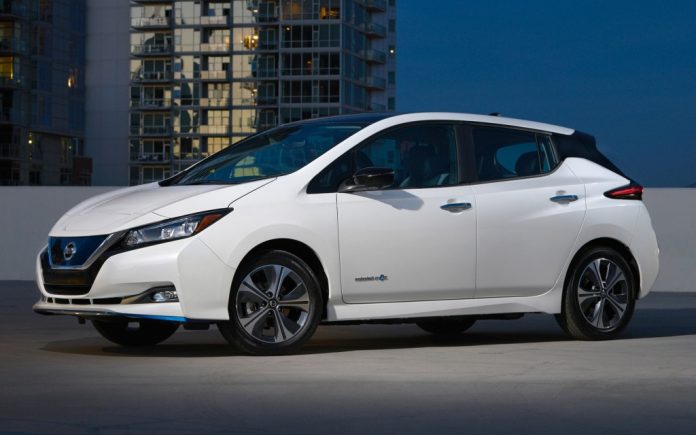

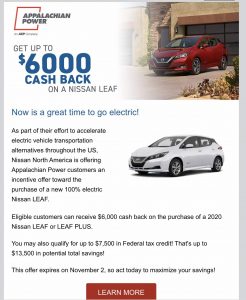
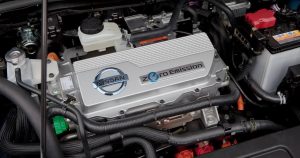









“Be aware that you’ll probably need to have some wiring work done at your home if you want to fast charge at home, since most homes were not wired for EV charging when they were built”
It’s certainly handy to plan to add either a Dryer Plug or a Stove plug near your preferred parking spot.
However many garages have been already wired to support a welder or high power air compressor and that will work adequately. Older homes pre War, were not set up for electric dryers or stoves and had to be upgraded. It’s a bit of work but there is some real convenience in charging at home.
Clover,
Most homes have a 240v dryer outlet in the washer/dryer room and one in the kitchen for a stove (if the house has electric appliances) but very few normally have these outlets in the garage unless the builder added it at the specific request of the home-buyer. So the choice is either to buy a cord long enough to reach the outlet you have – or to have a 240v circuit wired for the garage. One also may need more than just the outlet to safely charge the car on 240v, i.e., something like this: https://www.ebay.com/i/333600305343?chn=ps&norover=1&mkevt=1&mkrid=711-117182-37290-0&mkcid=2&itemid=333600305343&targetid=934800886496&device=c&mktype=pla&googleloc=9008708&poi=&campaignid=10877149672&mkgroupid=110621924121&rlsatarget=aud-622524041438:pla-934800886496&abcId=9300400&merchantid=6296724&gclid=CjwKCAiAzNj9BRBDEiwAPsL0d6XKKFGCRyndQprmdJeh_Cal4TpbbTf_8c3qMmS7f1NSL3kNEeZ4nxoCMecQAvD_BwE
The cost to “wire” a home for “fast” charging averages around $1,000 in parts and labor. This further adds to the total ownership cost of the EV and makes it economically absurd relative to a non-EV otherwise equivalent. The $1,000 all by itself is a sum that would buy about 500 gallons of unleaded, or about 41 tankfuls for a current year economy car with a 12 gallon tank. Enough to drive for about 16,000 miles – a solid year’s worth of transportation for the cost of making it feasible to “fast” charge the EV at home.
240V at what can be safely handled current wise at a residence isn’t even going to be fast like the commercial charge stations. It’s still going to be an overnight charge.
Indiana cop gets fired 2 hours after superviser reviews bogus harassment
https://www.nbcnews.com/news/us-news/indiana-officer-fired-after-stopping-black-men-nordstrom-rack-acting-n1085661
plandemic 2 – indoctrination
https://www.bitchute.com/video/MZ11m6zIxDch/
plandemic – covid agenda
https://www.bitchute.com/video/MZ11m6zIxDch/
Just saw this story:
https://arstechnica.com/cars/2020/11/chevrolet-issues-a-recall-for-2017-2019-bolt-evs-due-to-battery-fires/
Bolts catch fire if you recharge them beyond 90%. So now even less range.
Eric,
I think that comparing the Leaf to the Chevy Bolt and Kia Niro is fair; in order to get comparable range out of the Leaf, you’d have to spend $40K, which puts it in the ballpark with those other two cars.
Secondly, I don’t know if you can get a FAST charger (i.e. one that will recharge your car in less than an hour). You can get a faster charger rated at 240V vs. 120; that’ll cut charging times in half or so. Since dryers are often wired for 240, installing such a charger at home would be feasible.
The FAST chargers, such as the Tesla Superchargers, run at 480V or higher. Even if it’s possible to install that at home, wouldn’t it be too expensive? And for what? Isn’t the point of charging at home to recharge overnight while you’re asleep? A 240V charging system would be more than enough, since you’ll most likely be spending at least a few hours sleeping.
Also, it’s not good for the battery to constantly do fast charges on it. I don’t remember exactly why, but I seem to remember Tesla’s website saying that their Superchargers should be used for road trips only, while using the home charger (either 120 or 240) the vast majority of the time. I want to say that their website said that constant fast charges on the batter were bad for it or something.
Hi Mark,
I pointed out the Leaf’s lower price to start as an argument in its favor – because it is otherwise similar to the Bolt and Niro but many thousands less expensive. I actually think the Leaf makes more sense -if such a word is applicable – for this reason. Assuming you can operate comfortably within the 150 mile range.
Paying $40k for what is – other than the electric guts – a compact-sized economy hatch is . . . ludicrous. Neither the Bolt nor the Niro are quick (Tesla at least has that) or “nicer” than economy hatches half their price. Even the base Leaf at $30k is head-slapping ridiculous in terms of the math or any other metric other than “I just want an electric car and am willing to spend a lot of money to drive one” – which is perfectly fine.
A Corvette doesn’t make much sense, either. I’m all for people spending their money on whatever they want. Different strokes for different folks!
Looking at discussions on other boards, with incentives in certain states plus the federal tax credit the after-all-incentives price for a new base version can be as low as ~$11k.
I’d find it tempting at that price.
Over the weekend I retired an old gel cel backup battery for Lithium Iron Phosphate, so this is pretty timely. Lithium battery tech has different charging requirements than lead-acid or NiCad. Each cell must be monitored as they charge to make sure one doesn’t charge at a higher rate than the others. LiFePO drop-in lead acid replacement batteries can include a battery management system that takes care of all that, but the manufacturer will still have a recommendation for maximum charge current and voltage. Charge current can be less with good results at the expense of time, but undervoltage will leave capacity unused. Higher than recommended current might cause
But a good rule of thumb is a lower current is better for the battery. A slow rate of charge will greatly extend the life of the cells, which is why some Tesla owners report much longer life out of the battery pack than estimated. They charge at home, not at the supercharger stations.
who would vuluntarirl;y buy this thing? For a crippled car that I guess has some decent pickup and go/ Whoop dee do.
Hi Mark,
It doesn’t even have that. Yes, it feels strong coming off the line, but zero to 60 still takes about 8 seconds, in the same ballpark as a base Corolla or Mazsa3. Just twice as much – and goes half as far!
Did you get to drive it? If so did they bring it out to the woods or did you go to it?
Sounds like it would be the perfect 2nd car for a retired or semi-retired couple who doesn’t do much more than the Wuhan Flu restrictions allow. Trips to the grocery store and back home. Top it off in the garage. Repeat.